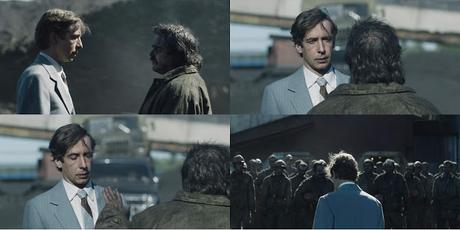
“When the truth offends, we lie and lie until we can no longer remember it is even there. But it is still there... Every lie we tell incurs a debt to the truth. Soon or later, that debt is paid.”
I’ve been reading horror novels of all kinds for the last few months, and somehow, Chernobyl, which is a detailed re-telling of the events preceding and following the catastrophe at the Chernobyl nuclear plant in April 1986 fits perfectly into those horror stories. The horrifying idea at the center of this is that the creation of scientists could veer so much out of control that it becomes a threat to humanity. The horror that it causes is a gory, transfiguring mauling of the flesh, and inescapable and sometimes invisible death. The toll that stopping that threat takes is both materially as well as morally unimaginable – there are many moments throughout the five episodes in which Soviet bureaucrats have to weigh the lives of the few against the lives of the many, and ask for impossible acts of heroism, or simply rely on a limitation of information to buy them cheaply.
In all of this, Chernobyl manages the impossible. It creates a procedural drama that captivates and yet also works towards a greater story about the end of a whole regime. The process of preventing the fall-out from becoming any worse turns into a race against time, bureaucratic obstacles, and the limitations of scientific progress. At one point, the men and women tasked with finding a solution to seal in the exposed reactor core to prevent it from emitting the equivalent of one nuclear bomb per hour realize that technological progress hasn’t come far enough to provide them with a robot that can remove the deadly debris of graphite on the roof of the plant – and so, the only solution is bio-robots, soldiers who have to remove the debris by hand in ninety-second intervals because any further exposure would be deadly. The group at the center of this, mainly Jared Harris’ scientist Valery Legasov and the vice-chairman of the Council of Ministers overseeing the disaster management, Boris Shcherbina (Stellan Skarsgård), solve one problem only to find that the solution has caused more. Early on, Legasov comes up with a solution to stop the fire that ends up opening a can of worms, which requires more human sacrifice. Sometimes, the process tips into the absurd, and leads the protagonists to the edge of their sanity, and yet the show never hesitates to show their power: their decisions are what sends divers, soldiers, miners and young men into sometimes unwitting danger, and those foot soldiers and pawns are never being told the truth, lest the great secret of the scale of the disaster comes out. This power dynamic at the center of the disaster management in Chernobyl goes up all the way – it takes the USSR days after the disaster to come close to revealing the extent of it to the countries surrounding, and impacted, by it. Once scientist Ulana Khomyuk (Emily Watson’s fictional character standing in for a whole group of people tasked with figuring out what exactly happened) starts to ask uncomfortable questions and finds even more uneasy truths, the conflict between truth-seeking and power becomes more and more obvious.
"Why worry about something that isn't going to happen?” Ah, that's perfect. Maybe they should put that on our money.The first part of the series is centred on the attempts to contain the spiralling catastrophe; the second part turns Chernobyl into a scientific crime that needs to be solved, if only to explain the inexplicable and to prevent this from happening again. The importance of Khomyuk’s quest for the truth becomes clearer and clearer as the human cost of the disaster is paid. The first to die are some of the plant engineers and workers, but the firefighters who rushed into the burning building, with no idea what they were facing, are met with a more cruel fate. In a crucial scene, Legasov explains how acute radiation syndrome progresses, and then we watch the firemen who entered the building and touched the debris suffer through it. Their bodies are burned, but there is a period of reprieve that falsely looks like recovery – the men play cards – but soon the horror continues, as their cells disintegrate and their bodies fall apart. Khomyuk witnesses the progression in the scientists and plant workers she has to interview to reconstruct in detail what happened, and neither she or Legasov have any doubt as to the human cost of what has happened. They are more concerned about the question that is asked, again and again, and that neither of them can answer for now: how could the reactor core explode?
The inexplicability of the events are part of the horror, as is the inevitability of both the environmental destruction – the abandoned houses, villages, cities, the animals that are killed by battle-hardened soldiers side-by-side with increasingly disillusioned students, and the unstoppable and progressive destruction of those who have come too close. It isn’t just the firefighters dying, or a whole group of people who watched the disaster evolving from a presumed safe distance perishing soon after, or even the wife of one losing her child later because she spent too much time close to the deadly, transfigured body of her husband – it’s the slow progression of a disease that is waiting for all those now working too close to the source of the radiation, a predictable future death of cancer that clouds every action. Legasov and Shcherbina know that their clock starting ticking, and is running out the more time they spend trying to solve this mystery. Chernobyl is precise in its historical details, but what it truly manages is capture the terror of the invisible death. It isn’t just the obvious horrors of it – the abyss of the remaining reactor, torn open, glowing menacingly, the bodies of the firefighters and engineers, deteriorating, finally buried in lead coffins and surrounded by concrete. There’s the many scenes in which someone progresses into the landscape with a Geiger counter, which quite literally ticks away seconds of their future. It’s those almost idyllic, disaster porn-like scenes of abandoned buildings, of entire housing blocks emptied out in a hurry, that look like so many other depictions of apocalyptic science fiction. I was born the January after these events, and in watching the show, I tried to remember how I conceptualised Chernobyl, which I would have been conscious of fairly early on. We did drills in school, and we followed warnings about avoiding areas and foods that were likely to have accumulated an unhealthy amount of radiation years later. This idea of an invisible danger, one that does now make itself known immediately but is deadly, and unstoppable, was planted early on, and fertilised well when we later read German YA novel Die Wolke (published in 1987). In that way, Chernobyl works like a horror trope, one that is so effective because it begins with childhood stories and is then replicated thousandfold in fiction.
Before Chernobyl, the extent of the catastrophe was unimaginable – the reference point would have been the nuclear bombs dropped on Hiroshima and Nagasaki. An explosion of the core was so unimaginable that Anatoly Dyatlov (Paul Ritter), chief-engineer of the plant, and the closest that Chernobyl comes to offering a conventional villain or antagonist, denied that the explosion occurred even after he heard several witnesses state that they saw graphite, which is only used inside the core, in the debris around the building. In the final episode, Chernobyl answers the question, and it does so by becoming a tense courtroom drama in which Khomyuk, and more centrally, Legasov, present their findings regarding the moments leading up to the explosion. It is a minute-by-minute reconstruction of all the incorrect and ill-informed decisions that were made, until the equation that Legasov presents of the tender balance within the reactor is doomed to tip, and the answer becomes obvious that there was no way for the explosion not to occur. The answer he arrives at first – that a career-hungry chief-engineer pushed the night-shift, which was neither prepared nor trained for this, to complete an exercise that had never before been successfully completed, that he disregarded cautions and warnings, that he arrogantly and aggressively disregarded safety – is both convenient for the viewers, yearning for someone specific to plain, as it is for the bureaucrats that the trial is really for. If it can all be blamed on one person going wrong, if it can be packaged neatly (as it was presented at the Atomic Energy Commission in Vienna), the regime can save face. Dyatlov is the perfect scapegoat, an entirely unlikable character – but Khomyuk pushes Legasov to arrive at a much less convenient and more uncomfortable answer, both for the regime and for him, personally, as the one who needs to gather his bravery and sacrifice his future career to reveal it.
In the reconstruction, they realised that the only reason why Dyatlov was so confident in pushing his team beyond their concerns was because he thought that the reactor had a failsafe, that there was a button that could be pushed to put an end it. But this Chernobyl – as it looms and glowers – had at that point already become a monster beyond its creators’ control. Pushing the button had the opposite effect - because the very graphite that has haunted this whole story, from being the first sign of the extent of the catastrophe to becoming the deadly objects that could only be moved by “bio-robots”, caused the explosion. Because, as Legasov puts it, giving the control rods graphite tips was a cost-saving measure, and since Dyatlov had no idea that this posed a danger, the extent of his responsibility for the accident is limited, and in fact it was a failing of the regime that allowed such cost-saving measures to prevail in spite of the dangers they posed. In the end, Chernobyl becomes about the moral responsibility to speak out even when the price this costs appears to be unbearable – perhaps to repay the debt incurred when Legasov and Shcherbina asked for that kind of sacrifice from everyone they employed to diffuse their ticking time bomb. It repays the moments when the miners, well-aware of the extent of danger they are being sent into, leave their marks on the man who commands them, to ensure that he is remains aware of their united power even when sending them to their possible deaths.
2019, created by Johan Renck, starring Jared Harris, Stellan Skarsgård, Emily Watson, Jessie Buckley, Paul Ritter, Adam Nagaitis, Sam Troughton, Robert Emms

